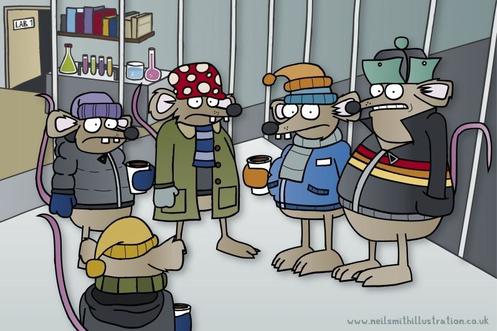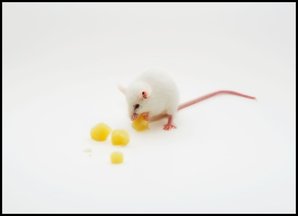|
The number of animals used in research each year is in the millions and the majority of these are mice. There are various reasons for this including the fact that mice are cheaper than larger animals, they reproduce faster, they are easy to handle, and the physiology and biochemistry of mice has many similarities with that of humans. Mice even develop many diseases that humans develop like cancer and diabetes. These traits have made mice the animal of choice for gene manipulation studies. As a result, many lines of mice which carry genetic alterations have been developed, and these have proven invaluable for studying disease processes in humans. Normally when researchers decide to employ an animal to study human disease they have to evaluate whether the animal models the disease adequately in humans. However, so many mouse disease models have been already established that most researchers go along with the prevalent practice in the field of employing certain models. And this makes sense, right? Why reinvent the wheel? After all, these models have been used before, they have led to reproducible observations, and key discoveries have been made with them. So, what do researchers do? They feed the mice the right diet, provide them with water, bedding etc. for their cages, and perform the experiments according to ethical guidelines. Researchers also make sure that they understand the variables they are dealing with, use the right controls, and execute the experiments in a competent fashion. What else is there to it? What about the temperature at which the mice are housed? Until recently if you asked researchers this seemingly mundane question they would draw a blank. They would probably answer that you keep the mice at room temperature of course. And comfortable room temperatures are around 20-22 °C. You don’t want to be doing experiments in a very warm environment where you are going to be dripping sweat over everything you are doing, and you don’t want to be doing experiments in a very cold environment where you are going to be shivering. Scientists have to make judicious decisions about what variables to control or keep track of in their experiments. You can’t control or keep track of everything. Why should housing temperature be an issue?  Several physiologists over the years have been sounding the alarm regarding the problem of housing mice at room temperatures, but only recently have their voices captured the attention of a critical mass of scientists. The problem is that housing mice at room temperatures of 20-22 °C is indeed comfortable, but for humans! As I have noted before in this blog, mice have a very large surface to volume ratio, therefore heat exits their body very quickly. This is why mice have a metabolism that is 7 times greater than that of a human. Room temperatures of 20-22 °C feel comfortable to us because at these temperatures we achieve thermoneutrality. This means that at these temperatures our bodies spend the least amount of energy in heating or cooling. However, for mice the temperature of thermoneutrality is around 30-32 °C and this is not a theoretical calculation. If a mouse is placed on a thermal gradient, these are the temperatures they seek. Mice housed at 20-22 °C are under a cold stress. So when researchers use mice housed at room temperature to model human disease, what they are really modelling is said disease on cold-stressed humans! Housing mice at human room temperatures dramatically changes their physiology and biochemistry and therefore the way they respond to disease and to drugs against diseases. For example, immunological responses are impaired in mice housed at room temperature which affects the way they respond to cancers and anticancer drugs. Also, mice housed at human room temperatures are more resistant to obesity and diabetes. The problem now is that millions of experiments ranging from basic science to drug development have been performed on mice housed at human room temperatures! So the question arises as to which of these results are valid? Do millions of experiments need to be repeated? Fortunately, the adaptations of animals like mice to a cold environment are well understood, and this knowledge can be used by researchers to estimate how much housing temperatures are likely to affect experimental results and then proceed to repeat any relevant experiments. In fact, this knowledge may present an opportunity to improve mouse models! It has been observed that many drugs that worked in mice did not work on humans beings, and the reason why this is the case is not clear. Could the housing temperature have had anything to do with it? This remains to be determined. Additionally, the right temperature to house mice may depend on what is being studied. Some phenomena involving increased energy expenditure and other related variables may actually be better modelled in mice housed at cold temperatures. Finally, housing at both cold and thermoneutral temperatures may give us a better understanding of how stress interacts with the variables involved in disease in ways that are relevant to patients. For example, mice bearing tumors tend to prefer significantly warmer temperatures (37-38 °C) than healthy mice, indicating that cancer induces a form of cold stress. This issue of the housing temperatures illustrates the importance of bringing experiences from several fields of science to bear on the methodological procedures to be followed. Scientists may be very smart and very competent, but they all have in depth training in their own field of study, and what may seem like an unimportant variable in one field may be recognized as something to keep under control in another. Image by Neil Smith available under a creative commons license: Attribution-NonCommercial-ShareAlike 3.0 Unported (CC BY-NC-SA 3.0).
0 Comments
The physical abilities of fleas are often compared with those of humans to highlight how remarkable these insects are. For example, a website took the record distance jumped by a flea which is 13 inches and reasoned that since a flea is 1/8 inch in length that means this flea jumped 110 times its length. The claim was then made that if a 5 foot tall human being were to try to equal this feat, such person would have to jump 550 feet, which is nearly the length of 2 football fields!  The above type of reasoning is probably to be expected when most people (including yours truly) have grown up reading books and watching movies where people, animals, or insects are resized by some fiat to very small or very large body dimensions. Just to name a few: Ant Man, Honey I shrunk the Kids, Them!, Fantastic Voyage, and the inhabitants of the nations of Lilliput and Brobdingnag in Gulliver’s Travels. The truth is that using this form of linear thinking when extrapolating from one body size to another is comparing apples to oranges. The mechanical strength of body structures and the physiology and biochemistry that living things rely on to move and survive at a certain body size are very different from those of living things that have vastly different body sizes. A 200 pound human needs to have a certain bone structure as well as the muscles to go along with it to be able to support such large weight. By comparison, a flea weighs 0.0000022 pounds and has a body designed to support this tiny weight. This is part of the reason why it can make those seemingly amazing jumps. A 200 pound flea would collapse and die unable to support its body weight and unable to breathe. If it could muster the strength to jump with a force proportional to when its size was small, it would tear itself to pieces. On the other hand, a human being the size of a flea would lose heat so fast that it would die from hypothermia if other problems don’t kill it first. A viable human the size of a flea would not look like a human being anymore, but it would probably be able to compete with fleas in several feats of strength. The above is not merely a curiosity. Scaling body sizes is an important and very complex discipline in pharmacology. For example, if the only information available regarding the dose of a drug to be administered comes from experiments performed with small animals, then based on that information what should be the starting dose to be administered to humans in a clinical trial? Or if the only information regarding dose comes from adults, what should be the starting dose to be administered to infants? The answer has to take into account several physical and biochemical parameters and is seldom straightforward. However, the linear thinking involved in the scaling of the flea to the human is out of the question. An example with tragic consequences of this thinking involved the sad case of Tusko the elephant. Tusko was an Asian elephant at the Lincoln Park Zoo in Oklahoma City. In 1962 researchers decided to administer LSD to this elephant to see if they could reproduce a physiological state related to rutting that makes male elephants very aggressive. To calculate the dose they used a reference dose employed in a cat and extrapolated it linearly on a milligram per kilogram basis to the weight of the elephant. When the elephant was administered the drug, it went into convulsions and died. The issue that the researchers did not recognize is that one pound of cat has a much higher metabolism than one pound of elephant. When metabolic rate is taken into account it can be worked out that this poor elephant received a dose that was ten times higher than the effective dose on cats! Issues of scaling do not pertain only to biological systems. For example, a chemist may use a certain synthetic procedure in the laboratory to make small amounts of a chemical to be used in research. However, if large quantities of this chemical are required, scaling up the procedure in an industrial setting is a very complex issue, especially if the procedure involves reactions that generate heat. In a previous post I mentioned how the large volume of an elephant related to its surface area causes heat to exit its body very slowly, whereas the opposite occurs in a mouse. Similarly the flow of heat out of a small reaction vessel in a research lab is much faster compared to that which takes place in the large volume of an industrial reactor. If heat production and flow in an industrial reactor are not controlled, something called a “runaway reaction” can occur which generates heat faster than can be removed. The buildup of heat from a runaway reaction can lead to explosions and fires like the one that happened at the Morton International plant in Paterson, New Jersey, in 1998. So by all means admire the feats of strength of tiny living things, and enjoy the next movie where some oversized critter terrorizes the city, but remember that in reality what works for the small will not work for the large and vice versa.  Here is a cool experiment that you can do at home. You can follow the link, but in a nutshell the experiment involves cutting a piece of cheese into cubes of different sizes. When you place these cheese cubes in a conventional preheated oven you find that the smaller cheese cubes melt first. However, if you place these cheese cubes in a microwave oven it is the larger cubes that melt first! How can this be? The explanation has to do with something called the surface to volume ratio. If you calculate the surface area of a cube and divide this by the volume of that cube, you will find that the smaller cubes have a greater surface to volume ratio than the larger cubes. So when you place the cheese cubes in a conventional oven, the heat enters the smaller cubes much faster (because they have more surface area relative to their volumes) than it enters the larger cubes. Most people that have tried to heat food in a conventional oven have experienced this. The center of bulky pieces of food may remain cold while the outside is hot, whereas smaller pieces heat up faster. But just in the same way that heat gets in faster into a small cheese cube that has a high surface to volume ratio, it is also true that heat can get out equally fast (dissipate) from such cubes. The microwave oven generates heat inside the cubes. In the larger cubes the heat has trouble moving out (because of the lower surface to volume ratio) and accumulates, heating the cube and melting it, whereas in the smaller cubes the heat escapes much faster and the cube doesn’t get as hot. The interesting thing is that this principle also applies to living things. Mice have a very high surface to volume ratio compared to a human being, and tend to lose heat very fast just like the small cheese cubes. This is why mice have a very high metabolic rate (expressed on a per body mass basis) to compensate for this large heat loss. If a mouse had the metabolic rate of a human it would die from hypothermia (lack of heat). Conversely if a person had the metabolic rate of a mouse, he/she would die from over-heating because the heat generated in the large volume of the human body would have trouble getting out through the limited surface area, just like in the large cheese cubes. If an elephant had the metabolic rate of a mouse it would (in theory) boil!  But even more interesting is that we owe our very existence to the principle of the surface to volume ratio. Compare our planet teeming with life to the barren wasteland that is Mars. The Earth is larger than Mars and therefore has a lower surface to volume ratio and cools slowly (like the large cheese cubes). All the heat that gets trapped inside the Earth as a result of this has melted its core, and the spinning of this core generates a magnetic field. This magnetic field protects the Earth against the solar wind, which would otherwise strip away our atmosphere. Unlike the Earth, Mars is smaller (has a high surface to volume ratio) and, like the small cheese cubes, it has cooled faster. As a result of this, its core solidified and stopped spinning a long time ago. When this happened, Mars lost its magnetic field and its atmosphere was stripped away by the solar wind. So there you have it. Who needs expensive labs or particle accelerators? Here is a fundamental physical principle responsible for life that holds true from mice to planets and that you can put to the test in your kitchen. Isn’t that cool? Now next time you get served cheese cubes and crackers at a cocktail party you can impress everyone by talking about the principle of the surface to volume ratio and heat transfer. Please remember to reference this blog! Mouse & Cheese Photo credit: Darny / Foter.com / CC BY-NC-ND Mars Photo credit: NASA Goddard Photo and Video / Foter.com / CC BY |
Details
Categories
All
Archives
June 2024
|
 RSS Feed
RSS Feed